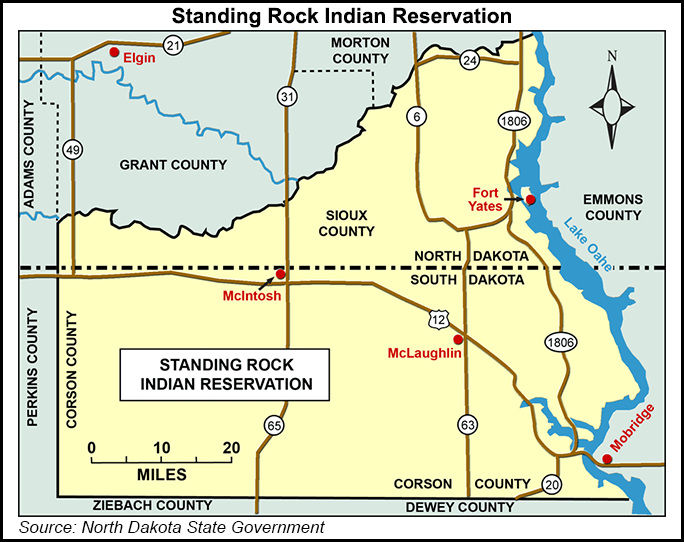Infrastructure | Bakken Shale | E&P | NGI All News Access
Dakota Access Pipeline in Limbo as Protests Continue
The nearly 1,200-mile, $3.8 billion Dakota Access Pipeline LLC (DAPL) starts the new year in limbo, though most of it has been built while activists continue fighting the project.

Houston-based Energy Transfer Partners (ETP) said Tuesday the 30-inch diameter pipeline for transporting Bakken Shale oil is built except for a Missouri River crossing under Lake Oahe in south-central North Dakota, near the border with South Dakota and the Standing Rock Sioux tribe reservation.
“Once we have the approval to cross the U.S. Army Corps of Engineers (USACE) land [near and under the lake], we will begin the horizontal directional drilling,” an ETP spokeswoman told NGI‘s Shale Daily. The drilling is to be more than 90 feet below the lake bed.
The pipeline sponsors missed the targeted in-service date of Jan. 1, but there are no financial or contractual consequences for missing it. “There is nothing tied to it,” the spokeswoman saidl.
“Pipelines and energy midstream assets are essential components of the energy value chain,” analysts at Woodstock, NY-based Miller Howard Investments wrote last month. “As of 2015, 76% of domestic U.S. crude oil [refinery receipts] was delivered via pipeline, however, energy infrastructure is aging. More than 50% of the nation’s pipelines were constructed in the 1950s and 1960s, and some were built even earlier.”
Records indicate that DAPL follows existing energy infrastructure running parallel near the proposed water crossing to the Northern Border natural gas pipeline built in 1982 under Lake Oahe and an overhead major electric transmission line, along with proposing to use the less-invasive horizontal drilling.
Standing Rock Sioux leaders contend their concerns have been ignored, but the USACE and pipeline sponsors counter that they have done everything possible to accommodate those concerns, including trying to meet with tribal leaders numerous times last year and making more than 140 modifications in the DAPL route in North Dakota alone to avoid potential conflicts with cultural resources.
The Native American tribes want the USACE to regulate the entire pipeline, but Congress long ago limited the federal agency’s authority to water crossings, which in this case is treated like a “single and complete project where activity will affect no more than a half-acre of regulated waters,” according to the Miller Howard analysis.
The protests continue near the Standing Rock reservation in North Dakota and elsewhere. Opponents contend that ETP may lose more than $900 million in backing for continuing delays imposed last month by the Obama administration.
During a National Football League game between the Minnesota Vikings and Chicago Bears on New Year’s Day at the US Bank Stadium in Minneapolis, two DAPL opponents calling themselves “water protectors” rappelled from the stadium rafters to display three large banners urging US Bank to divest from the pipeline project. Five demonstrators were arrested in North Dakota in late December for trespassing in Morton County. Up to 100 protesters reportedly also tried to remove a “no trespassing” sign from a bridge in the county that previously was the site of demonstrations against the pipeline.
On Wednesday a group of people demonstrated outside the U.S. District Court in Bismarck, ND, to support a fellow protester who was subpoenaed to appear for activities at the encampment near the pipeline water crossing. The activists claim that various U.S. agencies historically have “used subpoenas to federal grand juries” to force people to divulge the names and activities of other protesters.
© 2024 Natural Gas Intelligence. All rights reserved.
ISSN © 2577-9877 | ISSN © 2158-8023 |
